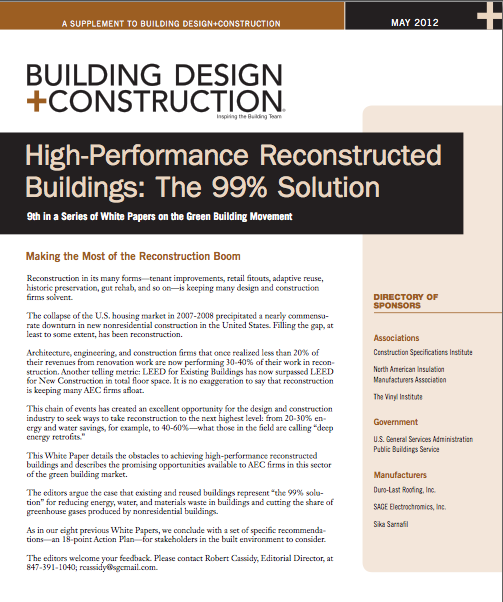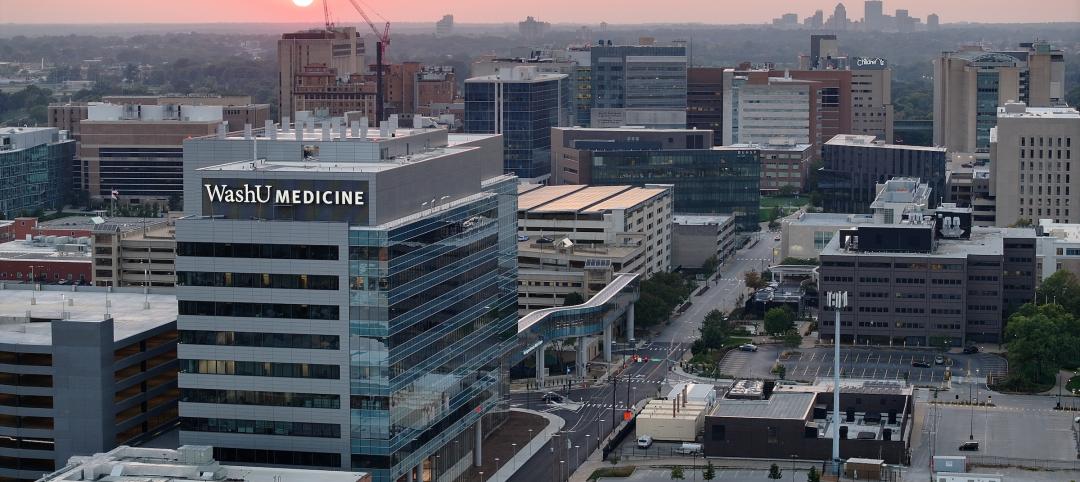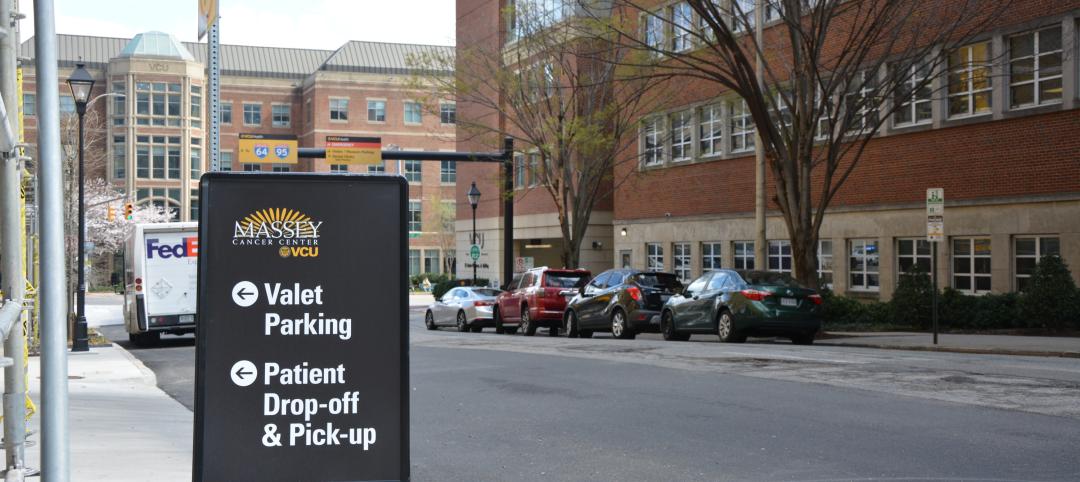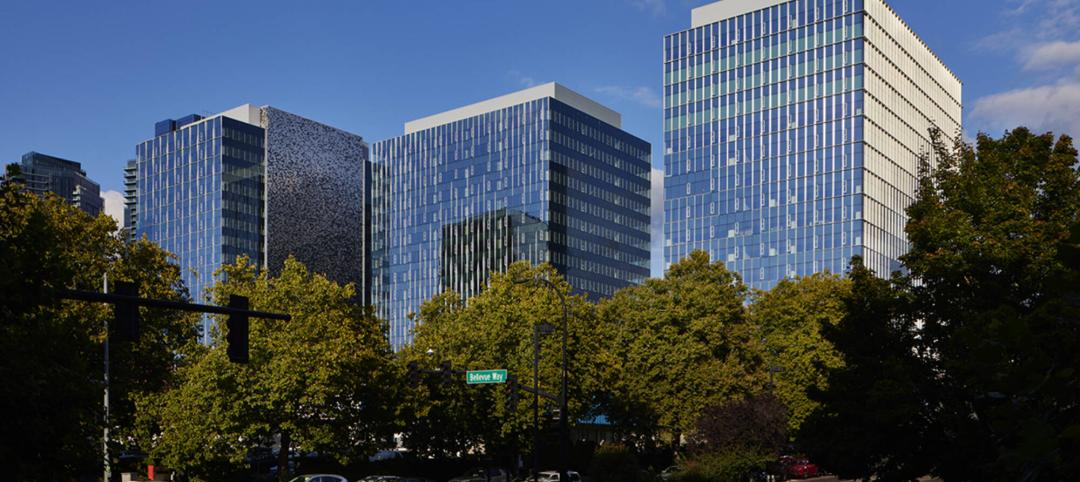Reconstruction in its many forms—tenant improvements, retail fitouts, adaptive reuse, historic preservation, gut rehab, and so on—is keeping many design and construction firms solvent.
The collapse of the U.S. housing market in 2007-2008 precipitated a nearly commensurate downturn in new nonresidential construction in the United States. Filling the gap, at least to some extent, has been reconstruction.
Architecture, engineering, and construction firms that once realized less than 20% of their revenues from renovation work are now performing 30-40% of their work in reconstruction. Another telling metric: LEED for Existing Buildings has now surpassed LEED for New Construction in total floor space. It is no exaggeration to say that reconstruction is keeping many AEC firms afloat.
This chain of events has created an excellent opportunity for the design and construction industry to seek ways to take reconstruction to the next highest level: from 20-30% energy and water savings, for example, to 40-60%—what those in the field are calling “deep energy retrofits.”
This White Paper details the obstacles to achieving high-performance reconstructed buildings and describes the promising opportunities available to AEC firms in this sector of the green building market.
The editors argue the case that existing and reused buildings represent “the 99% solution” for reducing energy, water, and materials waste in buildings and cutting the share of greenhouse gases produced by nonresidential buildings.
As in our eight previous White Papers, we conclude with a set of specific recommendations—an 18-point Action Plan—for stakeholders in the built environment to consider.
The editors welcome your feedback. Please contact Robert Cassidy, Editorial Director, at 847-391-1040; rcassidy@sgcmail.com.
Click here to download a PDF of High-Performance Reconstructed Buildings: The 99% Solution, the 9th in a Series of White Papers on the Green Building Movement
Chapter 1 Reconstruction: ‘The 99% Solution’ for Energy Savings in Buildings
Chapter 2 Exemplary High-Performance Reconstruction Projects
Chapter 3 How Building Technologies Contribute to Reconstruction Advances
Chapter 4 Business Case for High-Performance Reconstructed Buildings
Chapter 5 LEED-EB and Green Globes CIEB: Rating Sustainable Reconstruction
Chapter 6 Energy Codes + Reconstructed Buildings: 2012 and Beyond
Chapter 7 When Modern Becomes Historic: Preserving the Modernist Building Envelope
Chapter 8 High-Performance Reconstruction and Historic Preservation: Conflict and Opportunity
Chapter 9 The Key to Commissioning That Works? It Never Stops
Chapter 10 Action Plan: 18 Recommendations for Advancing Sustainability in Reconstructed Buildings
DIRECTORY OF SPONSORS
Associations
Construction Specifications Institute
North American Insulation Manufacturers Association
The Vinyl Institute
Government
U.S. General Services Administration Public Buildings Service
Manufacturers
Duro-Last Roofing, Inc.
SAGE Electrochromics, Inc.
Sika Sarnafil
Related Stories
Mass Timber | May 31, 2024
Mass timber a big part of Western Washington University’s net-zero ambitions
Western Washington University, in Bellingham, Wash., 90 miles from Seattle, is in the process of expanding its ABET-accredited programs for electrical engineering, computer engineering and science, and energy science. As part of that process, the university is building Kaiser Borsari Hall, the 54,000-sf new home for those academic disciplines that will include teaching labs, research labs, classrooms, collaborative spaces, and administrative offices.
Construction Costs | May 31, 2024
Despite challenges, 2024 construction material prices continue to stabilize
Gordian’s Q2 2024 Quarterly Construction Cost Insights Report indicates that supply chain issues notwithstanding, many commodities are exhibiting price normalization.
University Buildings | May 30, 2024
Washington University School of Medicine opens one of the world’s largest neuroscience research buildings
In St. Louis’ Cortex Innovation District, Washington University School of Medicine recently opened its new Jeffrey T. Fort Neuroscience Research Building. Designed by CannonDesign and Perkins&Will, the 11-story, 609,000-sf facility is one of the largest neuroscience buildings in the world.
Architects | May 30, 2024
AE firm Goodwyn Mills Cawood merges with Southland Engineering
Architecture and engineering firm Goodwyn Mills Cawood (GMC) is further expanding its services through a strategic merger with engineering firm Southland Engineering in Cartersville, Ga.
K-12 Schools | May 30, 2024
Inclusive design strategies to transform learning spaces
Students with disabilities and those experiencing mental health and behavioral conditions represent a group of the most vulnerable students at risk for failing to connect educationally and socially. Educators and school districts are struggling to accommodate all of these nuanced and, at times, overlapping conditions.
MFPRO+ New Projects | May 29, 2024
Two San Francisco multifamily high rises install onsite water recycling systems
Two high-rise apartment buildings in San Francisco have installed onsite water recycling systems that will reuse a total of 3.9 million gallons of wastewater annually. The recycled water will be used for toilet flushing, cooling towers, and landscape irrigation to significantly reduce water usage in both buildings.
Healthcare Facilities | May 28, 2024
Healthcare design: How to improve the parking experience for patients and families
Parking is likely a patient’s—and their families—first and last touch with a healthcare facility. As such, the arrival and departure parking experience can have a profound impact on their experience with the healthcare facility, writes Beth Bryan, PE, PTOE, PTP, STP2, Principal, Project Manager, Walter P Moore.
Urban Planning | May 28, 2024
‘Flowing’ design emphasizes interaction at Bellevue, Wash., development
The three-tower 1,030,000-sf office and retail development designed by Graphite Design Group in collaboration with Compton Design Office for Vulcan Real Estate is attracting some of the world’s largest names in tech and hospitality.
MFPRO+ News | May 28, 2024
ENERGY STAR NextGen Certification for New Homes and Apartments launched
The U.S. Environmental Protection Agency recently launched ENERGY STAR NextGen Certified Homes and Apartments, a voluntary certification program for new residential buildings. The program will increase national energy and emissions savings by accelerating the building industry’s adoption of advanced, energy-efficient technologies, according to an EPA news release.
Women in Design+Construction | May 28, 2024
Commerce Department launches Million Women in Construction Community Pledge
The U.S. Department of Commerce launched its Million Women in Construction Community Pledge this month to boost the ranks of women in construction companies. Federal investments are creating a construction boom that is increasing job opportunities for construction and trade workers.

















